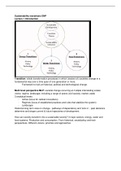Samenvatting
Extensive summary Sustainability Transitions: Concepts, Issues And Indicators (ENP23806) with all important aspects
- Instelling
- Wageningen University (WUR)
Summary of 28 pages for the course Sustainability Transitions: Concepts, Issues And Indicators at WUR (.)
[Meer zien]




